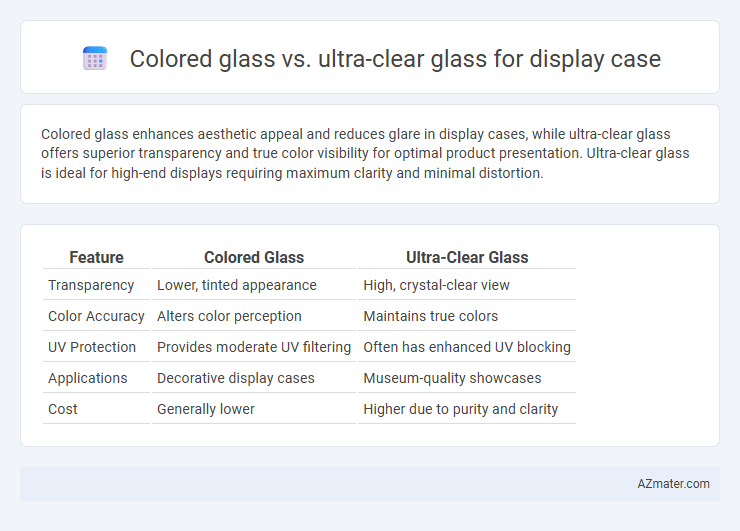Colored glass enhances aesthetic appeal and reduces glare in display cases, while ultra-clear glass offers superior transparency and true color visibility for optimal product presentation. Ultra-clear glass is ideal for high-end displays requiring maximum clarity and minimal distortion.
Table of Comparison
| Feature | Colored Glass | Ultra-Clear Glass |
|---|---|---|
| Transparency | Lower, tinted appearance | High, crystal-clear view |
| Color Accuracy | Alters color perception | Maintains true colors |
| UV Protection | Provides moderate UV filtering | Often has enhanced UV blocking |
| Applications | Decorative display cases | Museum-quality showcases |
| Cost | Generally lower | Higher due to purity and clarity |
Introduction: The Importance of Glass Choice in Display Cases
Selecting the right glass for display cases significantly affects both the aesthetic appeal and the visibility of exhibited items. Colored glass offers tinted hues that enhance visual interest and control light exposure, while ultra-clear glass provides superior transparency with minimal color distortion, ensuring true-to-life presentation. Understanding the specific needs of the display environment guides the optimal choice between colored and ultra-clear glass types.
What is Colored Glass? Characteristics and Uses
Colored glass for display cases is glass infused with metal oxides or other compounds to achieve a wide range of hues while maintaining transparency and strength. It offers enhanced aesthetic appeal and UV protection, making it ideal for showcasing art or collectibles that benefit from subtle lighting effects. Common uses include museum displays, retail showcases, and home decor where both visual impact and object preservation are key.
Understanding Ultra-clear Glass: Features and Benefits
Ultra-clear glass, also known as low-iron glass, offers exceptional transparency and minimal green tint, enhancing the visibility of items displayed in a case. Its higher light transmission rate compared to colored glass ensures true color representation and greater clarity, making it ideal for showcasing valuable collectibles or artwork. This glass type also provides superior UV protection and scratch resistance, preserving the display's aesthetic integrity over time.
Visual Impact: Color Accuracy and Transparency
Colored glass in display cases enhances visual impact by adding hue-based ambiance but can distort true color accuracy of displayed items, potentially altering perceived tones and details. Ultra-clear glass offers superior transparency with minimal green tint, delivering higher color fidelity and allowing true-to-life representation of objects without visual distortion. Selecting ultra-clear glass ensures optimal clarity and precise color rendering crucial for exhibits requiring authentic visual presentation.
Light Transmission and Display Clarity
Colored glass typically reduces light transmission, resulting in lower display clarity as it filters and tints the light passing through, which can alter the appearance of exhibited items. Ultra-clear glass offers high light transmission rates, often above 90%, ensuring true-to-life color representation and sharp visibility for displayed objects. This makes ultra-clear glass the preferred choice for display cases demanding maximum clarity and minimal visual distortion.
Durability and Maintenance of Each Glass Type
Colored glass for display cases offers enhanced durability due to its inherent thickness and resistance to scratches, requiring minimal maintenance primarily focused on regular cleaning with non-abrasive cloths. Ultra-clear glass boasts superior optical clarity and scratch resistance but demands careful handling and specialized cleaning solutions to prevent smudges and maintain its pristine appearance over time. Both types benefit from tempered glass technology, which significantly increases impact resistance and safety in high-traffic environments.
Cost Comparison: Colored Glass vs Ultra-clear Glass
Colored glass generally costs less than ultra-clear glass due to simpler manufacturing processes and the use of standard raw materials. Ultra-clear glass demands higher-grade raw materials and advanced production techniques, leading to increased costs often 20-40% higher than colored glass. Budget considerations typically favor colored glass for economical display cases, while ultra-clear glass suits premium displays requiring maximum clarity despite higher expenses.
Applications: When to Choose Colored or Ultra-clear Glass
Colored glass is ideal for display cases requiring enhanced aesthetic appeal and light filtration, often used in retail or art galleries to highlight specific visual effects or protect sensitive items from UV damage. Ultra-clear glass is preferred for high-end displays demanding maximum transparency and true color representation, commonly found in luxury stores and museums where clarity and detail are paramount. Choosing between colored or ultra-clear glass depends on the balance between visual impact and visibility needs of the displayed objects.
Environmental Considerations and Sustainability
Colored glass in display cases offers benefits such as reduced energy consumption during production due to lower processing temperatures compared to ultra-clear glass, contributing to a smaller carbon footprint. Ultra-clear glass, while requiring more energy for manufacturing, often incorporates advanced recycling technologies that enhance its environmental sustainability by reducing waste. Both types support eco-friendly practices, but selecting colored glass can provide greater advantages in minimizing environmental impact through reduced resource use and improved energy efficiency.
Conclusion: Making the Right Choice for Your Display Case
Choosing between colored glass and ultra-clear glass for your display case depends on the desired visual effect and the type of items being showcased. Colored glass adds artistic appeal and enhances thematic displays, while ultra-clear glass offers maximum transparency and true color visibility for high-value or detailed objects. Evaluating your display goals and lighting conditions ensures the best material selection to highlight and protect your collection effectively.

Infographic: Colored glass vs Ultra-clear glass for Display case
 azmater.com
azmater.com